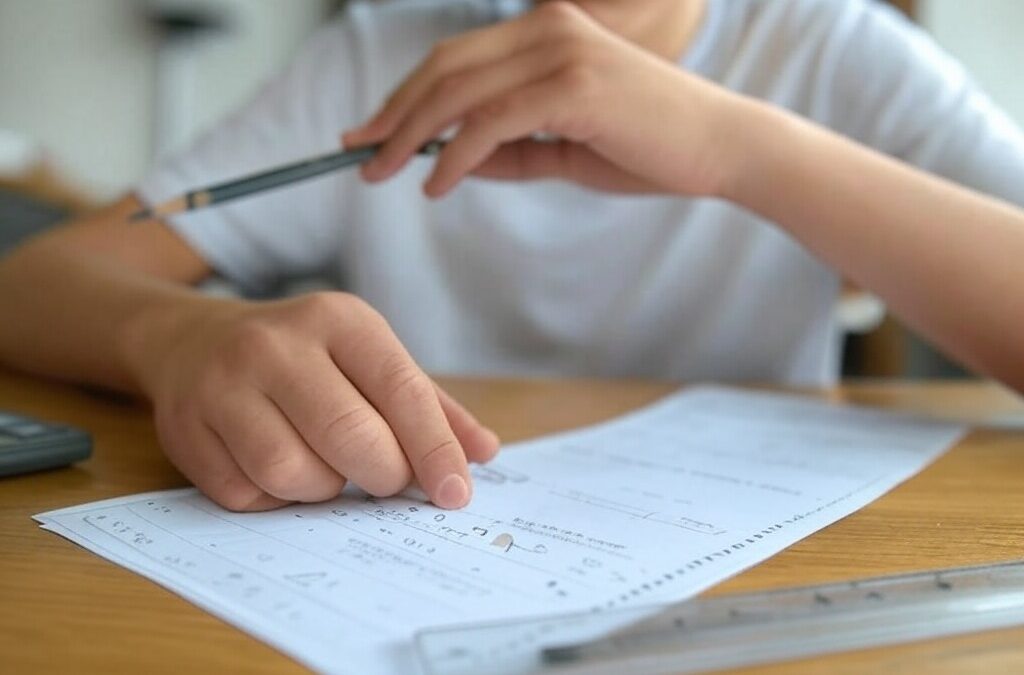
by TutorUp | Apr 16, 2025 | Parents and Home
Hey, parents! If your kid’s report card just landed like a plot twist you didn’t see coming, take a deep breath. Seeing grades that are lower than expected can feel heavy—for both you and your child. But here’s the good news: this is a moment to connect, support, and help your kid find their way. With a little patience and the right approach, you can turn this into an opportunity for growth. Let’s dive into some positive, practical ways to talk to your child about their grades and help them get back on track.
First things first, approach the conversation with curiosity, not judgment.
Kids are already their own toughest critics, and a lecture about “trying harder” might shut them down. Instead, create a safe space to talk. Maybe start with, “Hey, I noticed your grades this term. Wanna chat about what’s been going on?” This opens the door without making them feel like they’re in the hot seat. Listen more than you talk—really hear what’s behind those grades. Are they overwhelmed? Struggling with a specific subject? Or maybe it’s something outside school, like stress or distractions, that’s throwing them off.
Next, focus on effort over outcome.
Grades are just a snapshot, not the whole story of who your child is or what they’re capable of. Celebrate the things they’re doing well, even if it’s just showing up to class every day or tackling tough assignments. Try saying, “I’m proud of how you keep pushing through math, even though it’s tricky.” This builds their confidence and shows you’re on their team. Then, gently ask what they think might help them improve. Kids often have great ideas about what they need—they just need you to ask.
Problem-solving together is key.
If they’re stuck, suggest breaking things down. Maybe they need a better study routine, like setting aside 20 minutes after dinner for homework. Or perhaps they’re wrestling with a subject that feels like a foreign language. You could say, “What if we found some extra help for science? I bet there’s a way to make it click.” This collaborative vibe keeps them in the driver’s seat while showing you’ve got their back. If they’re feeling defeated, remind them that everyone hits bumps—share a story of a time you struggled and came out stronger. It’s a powerful way to normalize setbacks.
Keep the big picture in mind.
Grades matter, sure, but they’re not the end-all, be-all. Your child’s worth isn’t tied to a letter or number. Reinforce that school is about learning, growing, and figuring out what lights them up. Ask questions like, “What’s something you loved learning this week?” to shift the focus to curiosity and joy. This helps them see school as more than just a grade machine.
Finally, be their cheerleader.
Check in regularly, but keep it light—think, “How’s that history project going?” instead of “Did you fix that C yet?” Celebrate small wins, like finishing a tough chapter or raising a quiz score by a few points. These moments build momentum. And if you notice they’re still struggling, don’t be afraid to explore extra resources. Sometimes, a little outside help can make a big difference. Online tutoring, for example, can be a game-changer—platforms like TutorUp.com offer personalized support that fits into busy schedules and helps kids tackle tricky subjects at their own pace.
You’ve got this, and so does your kid. With open conversations, teamwork, and a sprinkle of encouragement, you can help them navigate this rough patch and come out stronger. Keep the faith—they’re learning, and so are you.

by TutorUp | Mar 20, 2025 | Online Tutoring
As a parent, you’ve likely noticed the ups and downs your child has faced in their education, especially in recent years. School disruptions, from pandemic-related closures to shifting schedules, have left many students grappling with learning loss. If you’re considering private, online tutoring to help your child catch up or even get ahead, you’re not alone. More parents are turning to this option, and for good reason: one-on-one online tutoring, delivered several times a week, has proven to be a powerful tool for boosting academic performance and remedying gaps in learning. Let’s explore why this approach might be the right fit for your child.
The past few years have underscored just how fragile academic progress can be. National testing data from 2022 revealed that students, on average, fell five months behind in math and four months in reading by the end of that school year, with even steeper declines for students in underserved communities. These setbacks don’t just disappear on their own—studies show they can linger, potentially costing students up to $61,000 in lifetime earnings if not addressed. That’s where online tutoring steps in as a targeted solution. Research consistently highlights its effectiveness, particularly when it’s personalized and frequent. A comprehensive review of 96 studies by the Annenberg Institute found that tutoring yields “consistent and substantial positive impacts” on learning outcomes, with gains equivalent to half a year to over a year of progress in just one academic year.
What makes one-on-one online tutoring so effective? It’s all about the tailored attention. In a typical classroom, teachers juggle the needs of 20 or 30 students, making it tough to zero in on your child’s specific strengths and struggles. Private tutoring flips that dynamic. Your child becomes the sole focus, allowing the tutor to adapt lessons to their learning style—whether they’re a visual learner who thrives on diagrams or a hands-on student who needs practice problems to grasp concepts. A study from San Bernardino Valley College showed that students receiving face-to-face tutoring (a close cousin to online one-on-one sessions) saw a 12% average increase in standardized test scores and outperformed their peers in 45 out of 52 academic subjects. Online tutoring mirrors this success, with the added flexibility of fitting into your family’s schedule.
Frequency matters, too. The evidence is clear: tutoring works best when it happens regularly—think three or more sessions a week, each lasting at least 30 minutes. This “high-dosage” approach, as experts call it, can accelerate learning by three to 15 months across grade levels, according to research from the Center for American Progress. It’s not just about cramming for a test; it’s about building a steady rhythm of support that reinforces classroom material and fills in gaps before they widen. For younger kids, like those in pre-K to first grade, reading tutoring has shown particularly strong results, while math tutoring shines for students in grades two through five. Imagine your third-grader, struggling with multiplication, finally clicking with the concept after consistent, focused help—online tutoring makes that possible without the logistical hassle of in-person sessions.
Beyond academics, there’s an emotional payoff. Kids often feel lost or anxious when they fall behind, and that stress can snowball into a lack of confidence. Regular one-on-one tutoring offers a safe space to ask questions and make mistakes, something they might shy away from in a crowded classroom. As their skills grow—say, moving from a C to a B in science—their self-esteem grows, too. Parents of upper-income households have caught on: one in five hired tutors during the pandemic to support distance learning, per the Pew Research Center. But you don’t need a big budget to see the benefits; online platforms have made tutoring more accessible, often at lower costs than traditional in-person options.
Of course, every child is different. If your kid thrives on structure and personal connection, the consistency of meeting the same tutor online several times a week could be a game-changer. Research from the National Student Support Accelerator shows that high-impact tutoring—small groups or one-on-one, frequent, and aligned with school content—moves the average student from the 50th to the 66th percentile. That’s not just a grade boost; it’s a leap toward excelling, not just catching up. So, is online tutoring right for your child? If they’re struggling with learning loss or simply ready to push their potential further, the data says yes—and the flexibility and proven results make it worth a serious look.

by TutorUp | Feb 19, 2025 | Online Tutoring
Nationwide, roughly 1 in 10 students participates in high-dosage, online tutoring (three or more tutoring sessions per week). This highly effective method has become increasingly popular, offering a blend of convenience, cost-effectiveness, and accessibility that traditional in-person tutoring might struggle to match. Here’s why online tutoring stands out as a compelling alternative:
- Flexibility and Accessibility: Online tutoring breaks the geographical barriers that in-person tutoring inherently faces. Students can now connect with top-tier tutors from anywhere in the world, without the constraints of location. This flexibility allows for scheduling that fits around busy lives, making education more accessible to those with tight schedules or living in remote areas.
- Example: A student in a rural town can now access a physics tutor from a prestigious university in another country, something virtually impossible with in-person tutoring.
- Cost-Effectiveness: Generally, online tutoring tends to be less expensive. Without the need for physical travel or maintaining a physical space, both tutors and students save on costs. This reduction in overhead often translates into lower rates for students.
- Insight: While in-person sessions might cost upwards of $60 per hour, online sessions can range from $20 to $60, making high-quality education more affordable.
- Enhanced Learning Tools: Modern online platforms come equipped with interactive whiteboards, screen sharing, and file sharing capabilities, which can sometimes offer a richer learning experience than traditional methods. These tools allow for real-time demonstrations, which are particularly beneficial for subjects like mathematics or sciences. Online sessions with one tutor and one student, face-to-face, are highly effective for tutoring.
- Technological Advantage: The use of technology in online tutoring can cater to different learning styles, providing visual, auditory, and interactive elements that might not be as dynamic in a physical setting.
- Personalization: One-on-one online tutoring can be highly personalized. Tutors can tailor their approach to individual learning styles, something that’s challenging in a classroom setting. The digital environment also allows for immediate access to a vast array of resources, which can be integrated into the lesson on-the-fly.
- Personalized Learning: Tutors can quickly adjust their teaching methods based on real-time feedback, ensuring the material is understood at the student’s pace.
- Safety and Comfort: Learning from home or a chosen environment can reduce anxiety for some students, providing a comfort zone that might enhance learning. This aspect is particularly noted in discussions around mental health and education.
- Comfort Factor: Students who might feel anxious in a formal classroom setting can find online tutoring more comfortable, potentially leading to better engagement and learning outcomes.
- Environmental Impact: While not directly related to learning effectiveness, the environmental benefits of reducing travel for tutoring sessions contribute to a broader educational ecosystem that values sustainability.
However, it’s worth mentioning that online tutoring isn’t without its challenges. The effectiveness can heavily depend on the student’s discipline, the quality of the internet connection, and the setup of the learning environment. For subjects requiring physical interaction or hands-on activities, in-person tutoring might still be preferred.
The effectiveness of online one-on-one tutoring as an alternative to in-person sessions is well-supported by its advantages in flexibility, cost, and technological integration. While it might not replace in-person tutoring entirely, especially for subjects requiring physical demonstration, it stands as a robust alternative that caters to the modern learner’s needs. The key to its success lies in leveraging technology to enhance, not just replicate, the traditional tutoring experience. For many, this digital shift in education represents not just an alternative but an evolution in how we approach personalized learning.

by TutorUp | Jan 2, 2025 | Parents and Home
UPDATED January 2025
In most cases, tutoring expenses are not a federal tax deductible item. There is an exception to this, for special education tutoring. Parents of children with learning disabilities such as dyslexia or ADHD may deduct tutoring expenses for their special needs child from their federal income tax, according to the IRS. If the child has a medically diagnosed learning disability, specialized tutoring is considered a medical expense if recommended by a doctor, and may be deductible if your total medical expenses exceed 7.5 percent of your adjusted gross income. This info can be found under the IRS Special Education section under the medical expenses that can be deducted.
Some states allow tax deductions for K-12 education and/or homeschooling expenses. Check your individual state regulations to see if your tutoring expenses may fall into the category of a deductible expense on your state return.
Other Help for Tutoring Expenses
- Many school districts have programs that assist with tutoring expenses for disadvantaged or low-income students. Contact your school’s financial aid office to see if they can connect you with financial aid resources for students in K-12. If your school doesn’t have a financial aid office, the school counseling office may be a good resource, or your school district administrator’s office can guide you.
- The federal government approved coronavirus relief money to fund “microgrants” for parents to use to hire tutors or teachers, but funds for these programs had to be committed by December 2024 to pay out by 2026.
- Some non-profits are funding tutoring programs for students who can’t afford private tutoring otherwise.
- Some states provide vouchers that can help pay for private education.
Is Private Tutoring Worth the Cost?
One thing most everyone can agree on is that education has suffered a huge setback due to the COVID-19 quarantines and subsequent shutdown of schools and regular school programs as we knew them. Student grades have suffered, test scores on assessment and achievement tests have dropped, and the dropout rate has soared.
Private tutoring is not a free service, and as such is not the solution for every child. However, many parents are rearranging budgets and prioritizing tutoring as a necessary expense instead of a luxury. For many parents, being able to hire a private tutor for their child not only helps the child catch up and keep up with grade-level schoolwork, but it also takes the burden off of the parent who may be juggling a lot right now. Lots of parents who work from home full-time or part-time welcome even a few hours a week of professional academic help for their kids.
How Tutoring Helps
The Hechinger Report, a national non-profit reporting exclusively on education, recently published an in-depth look at how tutoring is helping students right now: The Simple Intervention that Could Lift Kids Out of the “Covid slide”. They report that “tutoring is more effective than other measures” and the challenge is to expand it to support more kids. Individualized tutoring gives a child the one-on-one attention they can’t get in the classroom or doing virtual school. The results are impressive.
TutorUp Tutoring Services
TutorUp is committed to providing the highest-quality tutoring services at a reasonable cost, while paying our teacher/tutors a rate that their professionalism deserves. All of our tutors are certified, background-checked, experienced teachers who are professionals devoted to helping children succeed academically, one child at a time.
Whether your child needs help keeping up with the daily/weekly assignments that so many schools are using instead of a typical in-person all day school experience, or they have fallen behind and need help catching up, a tutor could be the help they need.
To find out more, and get matched with the perfect tutor for your child, let’s get started!

by TutorUp | Dec 12, 2024 | Online Tutoring
As a parent, watching your early learner struggle with reading can feel overwhelming. You’ve likely spent countless evenings going over the same words, sounding out letters, and trying to make sense of those beginner books, only to see frustration creep in—for both of you. It’s not uncommon for young kids to hit roadblocks with reading, but it doesn’t make it any less disheartening when your child isn’t progressing as quickly as you’d hoped. That’s where personalized online tutoring can step in and offer a lifeline, tailored specifically to your child’s needs.
One of the biggest advantages of this approach is how it zeros in on your child’s unique challenges. Maybe they’re mixing up similar-looking letters like “b” and “d,” or perhaps they’re having trouble connecting sounds to words. A one-on-one tutor, even through a screen, can take the time to figure out exactly where the disconnect is happening. Unlike a classroom setting where a teacher has to divide their attention among many students, individualized tutoring gives your child the full focus of someone trained to spot those sticking points and address them patiently. It’s like having a guide who’s walking alongside them, adjusting the pace and method until things start to click.
Another thing that makes this so valuable is the flexibility it brings to your family. Life is busy, and carving out time to shuttle your child to an in-person tutoring session might feel like one more thing on an already full plate. With online tutoring, your child can sit down at the kitchen table or in their room, log in, and get started. The comfort of being at home can ease some of that anxiety they might feel about reading, too. Plus, the tutor can bring in tools like interactive games or digital flashcards that feel less like work and more engaging, which can make a huge difference for a young learner who’s starting to dread books.
What’s really powerful, though, is how this kind of support builds confidence over time. When your child works with someone who’s rooting for them and celebrating every small victory—whether it’s mastering a tricky word or finishing a page without stumbling—they start to see themselves as capable. That shift in mindset can spill over into other areas, too, making them more willing to tackle challenges instead of shying away. As a parent, you get to witness that gradual transformation, knowing they’re not just memorizing words but actually learning how to read in a way that sticks.
If you’ve been feeling stuck or unsure about how to help your early learner with reading, personalized online tutoring might be worth exploring. It’s not about replacing what you’re already doing—it’s about adding a layer of support that’s customized to your child’s pace and personality. Seeing them light up as reading starts to feel less like a battle and more like an adventure could be the encouragement you both need right now. All TutorUp tutors are certified teachers, experienced in helping students master reading.

by TutorUp | Nov 13, 2024 | Education Topics
As your child approaches high school graduation, the question of “What’s next?” looms large. While college has traditionally been the go-to answer, trade schools offer a compelling alternative that can lead to lucrative careers, hands-on experience, and often, quicker entry into the workforce. Here’s a guide for parents on why and how to consider trade schools for your student.
Why Consider Trade Schools?
- Practical Skills: Trade schools focus on vocational training, providing skills that are immediately applicable in the job market. From welding to culinary arts, these skills are in high demand.
- Cost-Effective Education: Trade schools are typically less expensive than four-year colleges. This means less debt or even no debt for your child, which is a significant advantage in today’s economy.
- Shorter Programs: Most trade school programs last from a few months to two years, allowing students to start earning sooner rather than later.
- High Demand Jobs: Many trades are facing a shortage of skilled workers. This means job security and often higher starting salaries than entry-level college graduate positions.
- Hands-On Learning: Trade schools emphasize practical, experiential learning, which can be more engaging for students who learn by doing rather than through theoretical study.
Types of Trade Schools and Programs
Technical Colleges: Offer programs in technology, engineering, and health sciences. Think of fields like IT support, HVAC, or dental hygiene.
Vocational Schools: Focus on trades like automotive technology, construction, plumbing, and electrical work.
Culinary Schools: For those with a passion for food, these schools offer courses in cooking, baking, and restaurant management.
Art and Design Schools: For creatively inclined students, these schools might offer courses in graphic design, photography, or fashion design.
Cosmetology Schools: Training in hair styling, makeup artistry, and nail technology.
Steps to Choose the Right Trade School
- Assess Interests and Skills:
Start by understanding what your child is passionate about or naturally good at. This can guide you towards the right type of trade.
- Research Programs:
Look for schools that are accredited and have good job placement rates. Accreditation ensures the education meets certain standards, and high job placement rates indicate the program’s effectiveness.
- Visit Schools: If possible, visit the schools. See the facilities, talk to instructors, and meet current students or alumni.
- Financial Considerations:
- Scholarships and Grants: Many trade schools offer financial aid. Look into scholarships specifically for vocational education.
- Cost vs. Earnings: Consider the cost of the program against the potential earnings in that field.
- Career Prospects:
- Job Market: Check local and national job markets for the trade. Some trades might be more lucrative or in higher demand in certain regions.
- Hands-On Experience:
Ensure the program includes internships or practical training. Real-world experience is invaluable in trade careers.
Trade schools are not just an alternative to college; they’re a pathway to careers that are essential to our society, often offering immediate job opportunities and financial stability. As a parent, supporting your child in exploring trade school options could be setting them up for a fulfilling career with less financial burden. Encourage them to consider what they love doing and where their skills could make a real-world impact. Trade schools might just be the perfect fit for your high school graduate’s future.

by TutorUp | Oct 14, 2024 | Education Topics
The high school dropout rate is decreasing, which is a good thing, but we still have 6% of students dropping out before graduation. Many students feel that if they’re not planning to go on to college, they don’t really need to finish high school. If you need some help emphasizing the importance of finishing high school to your student, here are some reasons for them to stick it out:
1. Life Skills: The Ultimate Survival Kit
High school isn’t just about algebra and dissecting frogs (which, let’s be honest, might come in handy if you’re ever stranded on a planet where frogs rule). It’s about learning how to think critically, solve problems, and communicate effectively. These skills are like the universal translator of life; they work everywhere, from the boardroom to the backroom of a spaceship.
2. Career Opportunities: Not Just for Rocket Scientists
Even if your kid dreams of becoming the best burger flipper in the galaxy or a master plumber, many jobs require or at least prefer a high school diploma. It’s like having a basic access code to a wider universe of job opportunities. Plus, who knows? Maybe they’ll discover a passion for something that requires further education.
3. Financial Literacy: The Currency of the Cosmos
High school often teaches you how to manage money, which is like learning how to navigate through the asteroid belt of financial pitfalls. Understanding taxes, budgeting, and basic economics can save your kid from becoming a space pirate out of necessity.
4. Social Skills and Networking: The Human Connection
School is where you learn to deal with all sorts of life forms, from the quiet bookworm to the loud, sports-obsessed comet. These social skills are invaluable, not just for jobs but for life. Plus, the friends they make might just be the crew for their future starship.
5. A Foundation for Any Path
Whether they decide to go into trades, start a business, or become an intergalactic artist, high school provides a foundation. It’s like having a basic toolkit; you might not use every tool, but having them means you’re prepared for almost anything.
6. The Discipline of Completion
Finishing high school teaches discipline, the kind that says, “I can stick with something even if it’s not my favorite planet in the solar system.” This discipline is crucial for any endeavor, from learning a trade to mastering the art of intergalactic travel.
7. The Unexpected Journey
Life has a way of throwing curveballs, or in space terms, unexpected meteor showers. A high school education can be the difference between being prepared for these surprises or getting knocked off course.
While the path to college isn’t for everyone, the path through high school is like the yellow brick road of life skills, opportunities, and personal growth. Encourage your kids to finish this journey not because it’s the only way, but because it’s a well-equipped spaceship for whatever adventure they choose next. Remember, in the grand scheme of the universe, a high school diploma might just be the key to unlocking their potential, whether they’re headed to the stars or staying right here on Earth.

by TutorUp | Sep 10, 2024 | Parent and Tutor Resources
Homework time can be a battlefield, but with a bit of strategy, you can turn this daily skirmish into a productive, even enjoyable, part of your routine. Here’s how you can help your kids not just survive, but thrive with homework:
1. Set Up a Homework Station
First things first, create a space that says “I mean business.” This doesn’t have to be a grand setup; a quiet corner with good lighting, all necessary supplies, and minimal distractions will do. Make it a place where they want to work, not escape from.
2. Establish a Routine
Kids thrive on routine. Set a regular homework time. Whether it’s right after school or after dinner, consistency helps. This isn’t just about when they do homework, but how long. Set a timer if you need to, but keep it flexible for those “I’m on a roll” moments.
3. Be the Guide, Not the Doer
Your role is to guide, not to do the homework for them. Help them understand concepts, but let them apply it. Remember, it’s their learning, not yours. Plus, teachers can spot parent-done homework from a mile away!
4. Break It Down
Homework can seem like Mount Everest. Break it into base camps. Tackle one subject at a time, or divide big projects into smaller, manageable tasks. This makes the process less daunting and more achievable.
5. Use Technology Wisely
Tech can be a tool or a trap. Educational apps, online resources, and even YouTube tutorials can be goldmines for learning. But, set boundaries. No social media or gaming during homework time unless it’s for research (and we all know how that goes).
6. Teach Time Management
Show them how to prioritize. Start with the toughest subjects first when their mind is fresh. Use planners or digital calendars to track assignments. This isn’t just about homework; it’s a life skill.
7. Encourage Breaks
The Pomodoro Technique (25 minutes of work, 5-minute break) can be magical. It keeps the brain from burning out. Encourage them to stand up, stretch, or even do a quick dance. Movement boosts brain function.
8. Positive Reinforcement
Celebrate small victories. Did they finish their math without a meltdown? Praise that! Positive reinforcement can turn homework from a chore into a series of mini-triumphs.
9. Be Patient and Understanding
Some days will be harder than others. If they’re struggling, be there to listen. Sometimes, the problem isn’t the homework but something else. Being a supportive listener can make all the difference.
10. Review and Reflect
At the end of the week, review what worked and what didn’t. Did they finish homework on time? Were there any subjects they found particularly tough? Reflection helps in refining your approach.
11. Get Help When Needed
If homework consistently becomes a battleground, it might be time to seek external help. Tutors, homework clubs, or even talking to the teacher can provide new insights or strategies.
Remember, homework isn’t just about academic learning; it’s about teaching responsibility, time management, and problem-solving. By setting up the right environment and approach, you’re not just helping with homework; you’re equipping your kids with skills for life.

by TutorUp | Aug 19, 2024 | Online Tutoring
As the scent of freshly sharpened pencils fills the air, and the excitement (or dread) of “back to school” season hits, let’s talk about a secret weapon that can make this school year not just good, but *great* for your kids. I’m not talking about the latest in lunchbox tech or the coolest backpack trends, but something far more powerful: tutoring.
1. The Confidence Kickstart:
Imagine your kid walking into class, not with the usual first-day jitters, but with a swagger. Tutoring can ensure they’re not just caught up but ahead of the game. When they’ve already got a handle on what’s coming, their confidence soars. And confidence, my friends, is half the battle in school.
2. Personalized Learning – Because One Size Does Not Fit All:
In a classroom of 20 or more, teachers do their best, but let’s face it, your child’s learning style might be as unique as their fingerprint. Tutoring offers a bespoke educational experience. It’s like tailoring a suit; it fits perfectly because it’s made just for them.
3. Bridging the Summer Slide:
Ah, the summer slide, where all those hard-earned academic gains from last year take a vacation. Tutoring can be the bridge that keeps your child’s brain from turning into a mushy, sunbaked mess. A few sessions to review and refresh can make all the difference.
4. Homework Help That Actually Helps:
Let’s be real, homework can be a battleground. With a tutor, it becomes a training ground. They can explain those tricky concepts, help with organization, and make homework time less of a war zone and more of a learning zone.
5. Setting Goals and Achieving Them:
Tutors are like personal trainers for the mind. They help set realistic academic goals and then work towards them. This isn’t just about getting good grades; it’s about teaching your child how to aim high and succeed, a life skill if there ever was one.
6. The Social Aspect:
Tutoring isn’t just about academics. It’s also about social skills. Learning to interact with a tutor can improve communication, discipline, and even resilience. Plus, if they’re in a group setting, it’s a chance to make new friends who share their academic interests.
7. Early Intervention:
Sometimes, the first few weeks of school can reveal gaps in understanding. Tutoring can catch these early, preventing a small gap from becoming a chasm. It’s like having a personal academic GPS, rerouting before they get lost.
So, as you gear up for the “back to school” rush, consider adding tutoring to your arsenal. It’s not just about catching up; it’s about setting your child up for success in ways that go beyond the classroom. Whether it’s for a boost in confidence, personalized learning, or just to make homework a bit less of a headache, tutoring could be the key to unlocking your child’s potential this school year.

by TutorUp | Jul 15, 2024 | Online Tutoring
As summer rolls around, it’s easy to picture your kids kicking back, enjoying some well-deserved time away from the classroom. But here’s something that might catch your attention: while summer is a break from school, it’s also a time when a lot of what they’ve learned can slip away. Research shows that students can lose up to two months’ worth of reading and math skills over the summer if they don’t stay engaged. That’s not just a small hiccup—it’s a gap that teachers often spend four to six weeks reteaching when the new school year starts. For parents like you, who want your child to head into the next grade ready to tackle what’s ahead, summer tutoring might be the game-changer you’re looking for.
Let’s talk about that loss for a moment. Studies, like those from the National Summer Learning Association, back this up: about 30% of the progress kids make during the school year can vanish over those warm, unstructured months. It’s often called the “summer slide,” and it’s especially tough on students who are already playing catch-up. Maybe your child struggled with fractions last year, or perhaps reading still feels like a mountain to climb. Without some reinforcement, those weak spots don’t just stay weak—they can get worse. Summer tutoring steps in here, offering a way to not only hold onto what they’ve learned but also close those gaps before they widen.
What’s great about summer tutoring is how it can be tailored to your child’s needs. Unlike the school year, where teachers are juggling a whole classroom, a tutor can zoom in on exactly what your kid needs help with. Data from the Annenberg Institute at Brown University shows that high-impact tutoring—think frequent, focused sessions—can help students gain back half a year to a full year of learning in subjects like math and reading. That’s huge, especially if your child fell behind during a rocky school year or just needs a boost to feel confident walking into the next one. Imagine your third-grader finally nailing those multiplication tables or your middle schooler smoothing out their essay-writing skills—all before the first bell rings in the fall.
The flexibility of summer also makes this doable for busy families. With no homework or after-school activities crowding the schedule, you can fit tutoring around camps or vacations. And here’s a stat that might surprise you: a 2020 review of nearly 100 tutoring programs found that intensive tutoring was particularly effective for younger kids in reading and for slightly older ones in math. So whether your child is seven or twelve, there’s evidence this can work. It’s not about cramming their summer with busywork—it’s about targeted support that sets them up to start the year strong.
Think about September for a second. Kids who’ve had some summer tutoring don’t just show up refreshed—they show up prepared. They’re not the ones scrambling to remember what a decimal is or how to sound out tricky words while the teacher moves on to new material. Instead, they’re ready to build on what they already know. Research from the U.S. Department of Education highlights that students who get this kind of support are better positioned to keep pace as the year progresses, especially if they’ve had a tough time before. For you, that means less stress watching them struggle and more pride seeing them thrive.
If your child’s had a bumpy road with school—or even if they’re doing okay but could use a little edge—summer tutoring could be the bridge to a smoother next year. It’s an investment in keeping their skills sharp and giving them a head start. By the time fall hits, you might just find they’re not only caught up but actually excited to take on what’s next. And as a parent, isn’t that the kind of confidence you want them to carry into the classroom?

by TutorUp | Jun 10, 2024 | Education Topics, Online Tutoring
In recent years, a troubling trend has emerged in education: student math scores on standardized tests are dropping. From national assessments like the NAEP to international benchmarks like TIMSS, the data paints a clear picture of decline, raising alarms among educators, parents, and policymakers. But there’s hope on the horizon. Online math tutoring is emerging as a powerful tool to not only help students catch up but also push them beyond grade-level expectations. Let’s dive into the numbers, explore why this is happening, and see how personalized online tutoring could be the game-changer we need.
The Sobering Stats: A Decade of Decline
The evidence is stark. The National Assessment of Educational Progress (NAEP), often dubbed “The Nation’s Report Card,” has tracked a significant slide in math performance over the past decade. For fourth graders, average scores dropped from 223 in 2015 to 217 in 2022, with a further dip to 215 reported in 2024. Eighth graders fared worse, falling from 265 in 2015 to 260 in 2022, and down to 258 in 2024. That’s an 8-point drop for eighth graders in just under a decade—a decline experts call “historic” and “troubling.” Internationally, the Trends in International Mathematics and Science Study (TIMSS) echoes this, showing U.S. fourth graders losing 18 points and eighth graders dropping 27 points between 2019 and 2023.
The pandemic certainly played a role, with the steepest declines between 2019 and 2022 coinciding with school closures and disrupted learning. Yet, the downward trend predates COVID-19. Scores were already stagnating or slipping by the mid-2010s, suggesting deeper, systemic issues. Lower-performing students have been hit hardest, with the bottom 10% of eighth graders losing 19 points on TIMSS since 2019, widening gaps between high and low achievers. Today, nearly one in five U.S. eighth graders lack even basic math proficiency, a sobering reality with long-term implications.
Why Are Scores Dropping?
So, what’s behind this slide? The pandemic’s impact—lost instructional time, remote learning challenges, and disrupted routines—explains part of it, but not all. Experts point to a pre-existing stagnation in math education, possibly tied to curriculum shifts in the mid-2010s, like the Common Core, which some argue moved too fast past fundamentals. Others highlight a growing disconnect: students increasingly report math feels irrelevant to their lives, sapping motivation. Add in test anxiety, stretched-thin teachers, and a reliance on rote learning over conceptual understanding, and you’ve got a perfect storm eroding math skills.
The data also reveals inequities. Low-income students and students of color, already underserved, saw steeper drops post-pandemic. For instance, NAEP’s 2022 results showed Latino and low-income eighth graders slipping below basic proficiency, a level they’d surpassed in 2019. This isn’t just a math problem—it’s an opportunity problem, threatening future success in a world demanding ever-higher skills.
Online Math Tutoring: A Lifeline for Recovery
Here’s the good news: we’re not powerless against this decline. Online math tutoring offers a tailored, accessible solution to bring students back to grade level—and beyond. Unlike traditional classroom settings, where one teacher juggles 20–30 students, online tutoring delivers one-on-one attention, targeting each student’s unique gaps and strengths. Research backs this up: a 2020 study from the Annenberg Institute found high-dosage tutoring (30+ minutes, three times a week) can accelerate learning by three to 15 months. For math, where discrete skills build on each other, this personalized approach is gold.
Imagine a fifth grader struggling with fractions. In a crowded classroom, they might fall further behind as the teacher moves on. With an online tutor, they get focused practice—say, breaking down improper fractions with visuals like pizza slices—until it clicks. The tutor can then push them ahead, introducing decimals or ratios early, exceeding grade-level norms. Platforms like Khan Academy, Wyzant, or local programs connect students with skilled tutors who adapt lessons in real time, often at a fraction of the cost of in-person help. Since the pandemic, these services have boomed, with over half of U.S. districts using relief funds for tutoring, per the Education Department.
Beyond skill-building, online tutoring tackles the intangibles dragging scores down. It boosts confidence—crucial when 31% of teens now “never” or “hardly ever” read for fun, per NAEP’s 2022 survey, hinting at broader disengagement. Tutors teach test-taking strategies (time management, educated guessing) that ease anxiety and lift scores. Plus, the flexibility of online sessions fits busy schedules, making consistent support realistic for more families.
Exceeding Expectations, Not Just Catching Up
The goal isn’t just recovery—it’s excellence. Tutoring doesn’t have to stop at grade level. High-performing countries like Singapore, where 40% of students hit TIMSS’s top math tiers (versus 9% in the U.S.), show what’s possible with focused instruction. Online tutors can introduce advanced concepts early—think algebra basics for a fourth grader mastering multiplication—preparing students for STEM paths where the U.S. lags globally. A University of California study found tutored students outscored peers by 100 SAT points on average, proof this approach pays off long-term.
Time to Act
The drop in math scores is a wake-up call, but it’s not the end of the story. Online math tutoring offers a practical, proven way to reverse the trend, closing gaps and unlocking potential. Parents, schools, and communities should lean in—whether it’s lobbying for district programs or signing up for a session tonight. Every point regained is a step toward a future where students don’t just meet expectations but soar past them. Let’s not settle for stagnation. The tools are here; it’s time to use them.

by TutorUp | May 13, 2024 | Education Topics, Parent and Tutor Resources
Reading is a foundational skill that shapes a student’s academic success and lifelong learning. Yet, many students across the United States struggle to reach the reading proficiency expected for their grade level. This gap not only hampers their performance in school but also affects their confidence and future opportunities. Addressing this issue requires understanding what reading levels mean, recognizing the scale of the problem through statistics, and implementing effective solutions like one-on-one tutoring to help students catch up.
What Do Reading Grade Levels Mean?
Reading grade levels indicate the expected reading ability of a student based on their school year. These levels are often measured using standardized assessments, such as the National Assessment of Educational Progress (NAEP), which categorizes proficiency into four tiers: Below Basic, Basic, Proficient, and Advanced. Here’s a breakdown of what these levels typically represent across key grade milestones:
- Grade 1 (Ages 6-7): Students should recognize letters, decode simple words, and read basic sentences with support. This aligns with a reading level of about 1.0–1.9 on many scales, focusing on phonics and sight words.
- Grade 4 (Ages 9-10): By this stage, students are expected to read fluently, comprehend short chapter books, and infer meaning from text. The NAEP “Proficient” level for fourth graders includes understanding main ideas and vocabulary in context, roughly equivalent to a 4.0–4.9 reading level.
- Grade 8 (Ages 13-14): Eighth graders should handle complex texts, such as novels or informational articles, analyzing themes and drawing conclusions. Proficiency here corresponds to a reading level of about 8.0–8.9, requiring strong comprehension and critical thinking.
Being “below grade level” means a student struggles with the skills expected for their age group. For example, a fourth grader reading at a second-grade level might still stumble over multisyllabic words or miss the main point of a story, putting them at a disadvantage across subjects.
The Scope of the Problem: Statistics on Reading Struggles
Recent data paints a sobering picture of how many students are falling behind in reading. According to the 2022 Nation’s Report Card from the NAEP, 66% of fourth graders in U.S. public and non-public schools scored below the Proficient level in reading, with 31% falling Below Basic. For eighth graders, the numbers are even starker: 69% were below Proficient, and 30% were Below Basic. These figures reflect a persistent challenge, worsened by disruptions like the COVID-19 pandemic, which saw kindergarten reading readiness drop from 55% to 37% between 2019 and 2020.
The National Center for Education Statistics (NCES) further reported in 2023 that nearly half (49%) of public school students started the 2022–23 school year behind grade level in at least one subject, with reading often cited as a primary area of concern. Pre-pandemic, this figure was lower at 36%, underscoring the lasting impact of learning loss. Additionally, over 54% of American adults read below a sixth-grade level, suggesting that early struggles can persist without intervention.
These statistics highlight a critical issue: millions of students are not equipped with the reading skills needed to succeed academically or engage fully in society. The consequences are profound—students who lag in reading by third grade are four times less likely to graduate high school on time, a risk that jumps to six times for those from low-income families.
A Proven Solution: One-on-One Tutoring
To bridge this gap, one-on-one tutoring stands out as a highly effective strategy. Unlike classroom instruction, which must cater to a group, personalized tutoring tailors lessons to a student’s specific needs, pace, and learning style. Research consistently supports its impact. A 2020 meta-analysis by the Annenberg Institute found that high-dosage tutoring—defined as at least 30 minutes, three times a week with a trained tutor—can boost learning by three to 15 months across grade levels. For reading specifically, Johns Hopkins University studies show one-to-one tutoring outperforms other interventions, like small groups or computer-based programs, especially for students far below grade level.
Why does it work? One-on-one tutoring allows tutors to pinpoint gaps—like weak phonics or poor comprehension—and address them directly. It also builds confidence through consistent, supportive feedback, which is crucial for students who feel discouraged. For instance, a struggling fourth grader might work with a tutor on decoding skills using engaging texts at their current level, gradually building up to grade-appropriate material. This individualized approach contrasts with the one-size-fits-all nature of many classrooms, where teachers juggle diverse needs.
Moreover, tutoring can integrate with school curricula, reinforcing classroom learning. Programs like Reading Partners demonstrate this success, showing significant gains in phonological skills and verbal ability through structured, one-on-one sessions. With only 11% of public school students currently receiving high-dosage tutoring (NCES, 2023), scaling up access could transform outcomes for the millions lagging behind.
Moving Forward
The reading crisis among students demands urgent action. With nearly two-thirds of fourth and eighth graders below proficiency, and half of students starting the year behind, the stakes are high. One-on-one tutoring offers a practical, evidence-based way to help students catch up, equipping them with the skills to thrive academically and beyond. Schools, districts, and communities must prioritize funding and implementing these programs, ensuring every child gets the chance to read at their potential. The investment isn’t just in literacy—it’s in their future.

by TutorUp | Apr 11, 2024 | Parents and Home
As a parent, you’ve likely seen how your child’s mood and energy can shift after a day spent running around versus one glued to the couch. It’s not just about burning off steam—physical activity has a direct tie to how well their brain works, especially when it comes to learning. Kids’ minds are wired to grow and adapt, and movement is like a key that unlocks their potential. On the flip side, too much inactivity can quietly chip away at that, leaving them less equipped to handle school’s demands.
Boosting brain power
When kids move—whether it’s playing tag, riding a bike, or even just walking to the park—their brains light up in ways that support learning. Research shows that regular physical activity boosts blood flow to the brain, delivering oxygen and nutrients that sharpen focus and memory. One study found that kids who get at least 60 minutes of moderate exercise a day—like a brisk game of soccer or a dance session—score higher on tests of attention and problem-solving than their less active peers. It’s not magic; it’s biology. Exercise triggers the release of proteins like BDNF, which help grow new brain cells and strengthen connections, especially in areas tied to reasoning and recall. So, when your child comes back from recess or gym class, they’re not just tired—they’re primed to take in what’s next on the lesson plan.
Less activity means lower scores
Inactivity, though, tells a different story. Sitting for hours—whether it’s scrolling on a tablet, watching TV, or even grinding through homework without a break—can dull those same brain processes. Studies link prolonged sedentary time to weaker cognitive performance, especially in younger kids whose brains are still developing. It’s not just about missing out on exercise; sitting too long can mess with blood sugar and slow circulation, leaving their minds foggy and less responsive. One report noted that kids who spend more than two hours a day on screens tend to have lower scores in language and thinking skills. That’s time that could’ve been spent moving, which doesn’t just wake up their body but keeps their brain from stalling out.
Emotional health is tied to physical activity
What’s really striking is how movement ties into their emotions, too. Physical activity cuts stress and anxiety—things that can clog up a child’s ability to focus or retain what they’re taught. A quick game of catch or a jog around the yard pumps out endorphins, leveling out their mood so they’re ready to sit down and tackle math or reading. Without that outlet, pent-up energy or frustration can fester, making it harder for them to settle into learning. You’ve probably noticed this yourself—a restless kid who can’t sit still isn’t exactly in the zone for a history lesson. Inactivity lets that restlessness build, while even a short burst of activity can reset them.
Incorporate fun activities
You don’t need to turn your child into an athlete to see the benefits. The key is weaving movement into their day in ways that fit your life. A family walk after dinner, a dance party in the living room, or letting them bike to a friend’s house can all add up. Aim for that 60-minute mark of activity—broken up if needed—and try to cap long stretches of sitting. If they’re stuck on homework, a five-minute stretch or jog around the house can jolt their brain back on track. The less they’re parked in one spot, the more their mind stays engaged. It’s not about pushing them hard; it’s about keeping them active enough to let their natural curiosity and smarts shine through.
Seeing your child struggle with focus or confidence in school is tough, and inactivity might be a sneaky part of that puzzle. Flip it around with some regular movement, and you’re not just helping their body—you’re giving their brain a real shot at keeping up and pushing forward. They’ll head into class sharper, steadier, and maybe even a little prouder of what they can do. That’s worth getting them off the couch for, right?

by TutorUp | Mar 18, 2024 | Parents and Home
As a parent, you’ve probably noticed how your child’s energy and focus can shift from day to day. Maybe they’re sharp and engaged one morning, then sluggish and distracted the next. What they’re eating could be playing a bigger role in that than you might think. Nutrition isn’t just about keeping them full—it directly impacts how well their brain functions, which in turn affects their learning. For school-age kids, whose minds are still developing, what’s on their plate can either fuel their success or quietly hold them back. Let’s unpack this a bit and talk about how you can set them up to thrive with some simple food choices.
How the brain is impacted
The brain is an energy-hungry organ, and it relies on a steady supply of nutrients to keep things like memory, attention, and problem-solving in gear. Research backs this up—studies show that kids with balanced diets perform better on tests and have stronger concentration than those who don’t. Take breakfast, for example. After a night of fasting, their brains need a recharge. Something like oatmeal with berries or scrambled eggs with whole-grain toast can give them slow-burning carbs and protein to sustain energy through those morning classes. Skip that—or worse, send them off with a sugary pastry—and their blood sugar spikes and crashes, leaving them foggy by mid-morning. It’s not just about filling their stomachs; it’s about giving their brains what they need to tackle math problems or follow a story in English.
What about snacks?
On the flip side, some foods can work against them. Processed snacks heavy in sugar or saturated fats—like chips, candy, or fast food—might taste good but can dull their mental edge. Studies link diets high in these to slower cognitive processing and even mood swings, which can make a tough school day feel even harder. It’s not that they can’t ever have a treat, but leaning too much on these can sap their focus over time. Instead, think about swapping in options that support their learning. Nuts or yogurt make great snacks—rich in healthy fats and protein to keep them steady without the sugar rollercoaster. Even something as simple as sliced apples with peanut butter can do the trick.
Focus on drinks
Hydration matters just as much. A dehydrated brain is a sluggish one, and kids often don’t realize they’re thirsty until it’s affecting them. Research shows even mild dehydration can impair attention and memory—two things they can’t afford to lose when they’re trying to grasp new concepts. Water’s the best bet here, plain and simple. Sugary drinks like soda or juice might seem refreshing, but they pile on empty calories and can lead to that same energy crash. Keeping a water bottle handy, maybe with a splash of lemon if they’re picky, can make a real difference in how alert they stay.
A balanced dinner
Dinner’s another chance to set them up for success. After a long day, their brains are still processing what they’ve learned, and sleep is when a lot of that locks in. Foods rich in omega-3s—like salmon or chia seeds—support memory and cognitive growth, while complex carbs like sweet potatoes or quinoa give them steady energy to wind down without a sugar jolt. Try to steer clear of heavy, greasy meals late at night; they can mess with sleep quality, leaving your child groggy for the next day’s lessons. A balanced plate doesn’t have to be fancy—just intentional.
Don’t try to change everything at once
You don’t need to overhaul everything overnight. Start small—maybe trade the morning Pop-Tart for a smoothie with spinach, banana, and a scoop of almond butter. Toss some veggies into their lunch or keep a stash of trail mix for after school. The goal isn’t perfection; it’s consistency. When their brain’s getting the right fuel—lean proteins, whole grains, fruits, veggies, and plenty of water—they’re better equipped to learn, retain, and grow. And as a parent, knowing you’re helping their mind stay sharp might just ease some of that daily worry about how they’re doing in school.

by TutorUp | Feb 16, 2024 | Parent and Tutor Resources
Tips even math-challenged parents can use
Not all of us are great at math, but adults understand that basic math skills are essential to everyday living. Kids who are struggling with math often feel defeated and can’t see any practical reasons for learning math. One major way parents can help is to try to instill a positive attitude towards math.
If you’re wondering how to relate math to everyday life so your child understands how important it is, here are some great examples that show how math is a life skill every person needs:
- Finance and Budgeting. Math skills help with personal finances like budgeting, managing money, financial analysis, investments, mortgages, etc. Strong math skills can lead to higher earnings over time.
- Everyday Decision Making. Day-to-day decisions like finding best deals, discounts and percentages, calculating tips, estimating costs and quantities – all rely on good math.
- For many jobs and careers. Complex math, statistics, and analytical skills are used in sciences, engineering, economics, medical, technology, and business fields. Basic math is essential for most jobs.
- Home improvement projects – being able to estimate, accurately measure, and calculate the right amount of things like building materials, paint, etc. is really helpful.
- Cooking and following recipes – Understanding quantities, measuring ingredients properly, adjusting recipe sizes, and calculating cooking times.
- Problem solving ability – The analytical and critical thinking skills developed in mathematics help frame and solve all kinds of complex problems.
- Analytics and technology tasks – Managing data, building models, analyzing results to drive decisions and insight relies on strong math skills.
Besides just showing how essential it is to be proficient in math, here are some good ways parents can help a child who is struggling with math:
- Play math games and do math puzzles occasionally to make it fun. There are many math games, apps, and books with a gaming angle.
- If they are struggling with a concept, try using concrete objects and examples to demonstrate and allow hands-on learning. For example, use blocks when learning about fractions.
- Work with them on math homework, going through it step-by-step and teaching the concepts. Resist the urge to give them the answers, instead help them reason their way through.
- If you see them getting frustrated, approach the problem from a different angle or take a quick break so they stay motivated. Encourage them that steady practice will lead to progress.
- Connect them to resources like online tutorials, tutoring, or math learning centers if available. Especially for higher level math, a tutor can provide expertise.
- Talk to their math teacher so you understand where they are struggling. The teacher may be able to provide additional practice or custom re-teaching if needed.
Above all, be patient and encouraging. Overcoming math struggles takes time for most kids, but with consistent support they can get there. Praise their hard work and celebrate small wins.
















